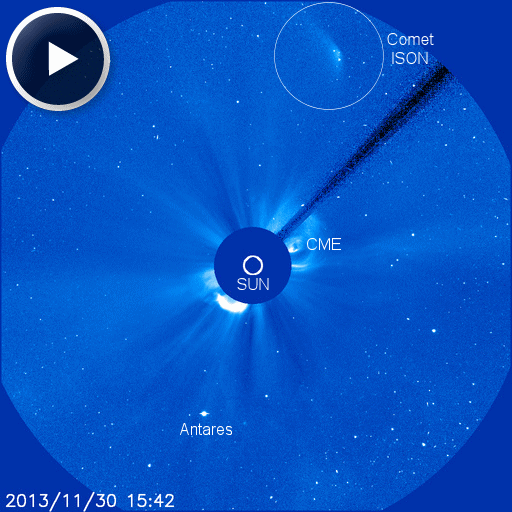CHANCE OF FLARES: Earth-facing sunspots AR1907 and AR1908 have 'beta-gamma' magnetic fields that harbor energy for moderately strong flares. NOAA forecasters estimate a 25% chance of M-flares and a 5% chance of X-flares on Nov. 30th. Solar flare alerts: text, voice
COMET ISON DIES ... AGAIN: Comet ISON is fading fast as it recedes from the sun. Whatever piece of the comet survived the Thanksgiving flyby of the sun is now dissipating in a cloud of dust. Click to view a 3-day movie centered on perihelion (closest approach to the sun):
This development makes it unlikely that Comet ISON will put on a good show after it exits the glare of the sun in early December. Experienced astrophotohtaphers might be able to capture the comet's fading "ghost" in the pre-dawn sky, but a naked-eye spectacle can be ruled out.
On Nov. 29th, pilot Brian Whittaker tried to catch a first glimpse of Comet ISON from Earth, post-perihelion, from a plane flying 36,000 feet over the Arctic Circle in northern Canada. No luck:
"Ideal viewing conditions from the Arctic revealed no Comet ISON," reports Whittaker. "This negative report is to quench the thirst of other fellow dreamers under cloudy skies or further south. Later I could see that SOHO showed the comet dimming further."
Despite Whittaker's negative result, it is too soon to rule out observations from Earth as the twice-dead comet moves away from the glare of the sun. Meanwhile, NASA's fleet of solar observatory will be tracking the remains. Stay tuned for more images.

Solar wind
speed: 405.8 km/sec
density: 5.0 protons/cm3
explanation | more data
Updated: Today at 1727 UT
X-ray Solar Flares
6-hr max: B8 1459 UT Nov30
24-hr: B8 1459 UT Nov30
explanation | more data
Updated: Today at: 1700 UT
![]()
Daily Sun: 30 Nov 13
Sunspots AR1907 and AR1908 have 'beta-gamma' magnetic fields that harbor energy for M-class solar flares. Credit: SDO/HMI
![]()
Sunspot number: 95
What is the sunspot number?
Updated 30 Nov 2013
Spotless Days
Current Stretch: 0 days
2013 total: 0 days (0%)
2012 total: 0 days (0%)
2011 total: 2 days (<1%)
2010 total: 51 days (14%)
2009 total: 260 days (71%)
Since 2004: 821 days
Typical Solar Min: 486 days
Update 30 Nov 2013
The Radio Sun
10.7 cm flux: 129 sfu
explanation | more data
Updated 30 Nov 2013
![]()
Current Auroral Oval:
Switch to: Europe, USA, New Zealand, Antarctica
Credit: NOAA/POES
![]()
Planetary K-index
Now: Kp= 2 quiet
24-hr max: Kp= 2 quiet
explanation | more data
Interplanetary Mag. Field
Btotal: 6.8 nT
Bz: 4 nT south
explanation | more data
Updated: Today at 1727 UT
![]()
Coronal Holes: 30 Nov 13
There are no large coronal holes on the Earthside of the sun. Credit: SDO/AIA.






